Metamorphosis
Magic is, at its core, a game about change. I believe the reason that Magicis as healthy as it is (and has lasted as long as it has) stems from the fact that R&D accepts that Magic is an ever-evolving system. We don't fight change but rather allow it to be a tool that lets the game constantly reinvent itself. We use this as an opportunity to keep making Magic better and better.
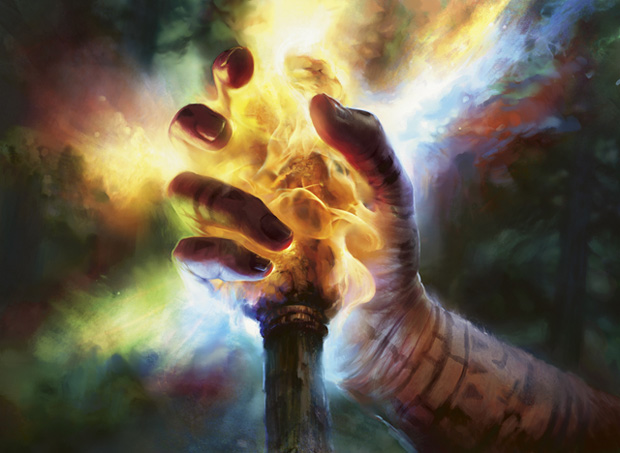
Art by Adam Paquette
Today is a special article because Magicis about to go through a metamorphosis. Our little caterpillar is getting ready to wrap itself into a cocoon and I am honored to be the one to introduce you to the new butterfly that will emerge. Yes, big change is coming and it's pretty damn exciting!
Big change? How big? Very big. I'll put it this way. This is the kind of article where when you finish (and please, please, please read the whole thing) you're going immediately go to social media to discuss it because it's that much of a game changer. At this point, I'm guessing some of you are thinking I'm exaggerating a little. As you will soon see, I am not.
Here's what I'm going to do. I am going to start by explaining a number of issues we've had with the game. I will then elaborate on the thought process that led to the changes I am about to discuss. And then I will walk you, step by step, through all the changes. I know readers love to skim, but if ever there was a day to read all the words, today is that day. There's a lot about to happen and I want to make sure you all understand exactly what it entails.
Magic is a great game and the way R&D works to keep it that way is by constantly looking to find ways to improve it. The key to doing this is being willing to accept that there are always things we can do better. To understand the changes that are about to come, we must first look at some of the issues R&D has been trying to solve.
A quick note before I begin. In this article, I need to talk about the times of year certain expansions get released. In order to do this, as the dates shift from year to year, making months hard to use, I'm going to talk about the seasons as they apply in the Northern Hemisphere. For any readers from the Southern Hemisphere, please swap in the correct season accordingly.
#1—The Third-Set Issue
Here's the issue. Every year, we make a block that consists of three expansions: a large fall set, a usually small winter set that comes out in the beginning of the next calendar year, and a third set—sometimes small, sometimes large—that comes out in the spring. Those sets almost always take place in the same world and have a continuous story. When the third set is large, we tend to reboot the mechanics and have the set drafted by itself (Khans of Tarkir block is doing something a little different).
Since the beginning of the block structure (Mirage block, way back in 1996), the third set has always been a problem child. It needs to have enough cohesion to feel as if it belongs to the block, but it has to have enough differences that it manages to spark the interest of the players, who have already been playing the environment for seven or more months.

We've tried all sorts of tricks: sharp mechanical turns, strong divisions, major story events, a complete mechanical reboot, etc. Eighteen years later, we're still struggling. In fact, in last week's "State of Design" article, I explained how, in Theros block, we overcompensated for the third set, causing the second set of the block to suffer. Suffice to say, this is a problem we've been trying to tackle for a long time.
#2—The Core-Set Issue
At least once a year, we get a bunch of R&D people into a room and have the following discussion:
Who exactly is the core set for? If it's for beginners, why do we only put it out during one point of the year? Is that the one time we expect new players to start? And why do we keep adding new cards and bringing back mechanics? The beginners don't need any of that and it only leads to making the set more complicated.
If it's for the experienced players, why do we keep the overall complexity so low? Why do we only use returning mechanics and only one at a time? Why do we strictly limit what the set can do? The experienced players don't need any of that and it only leads to making the set less engaging.
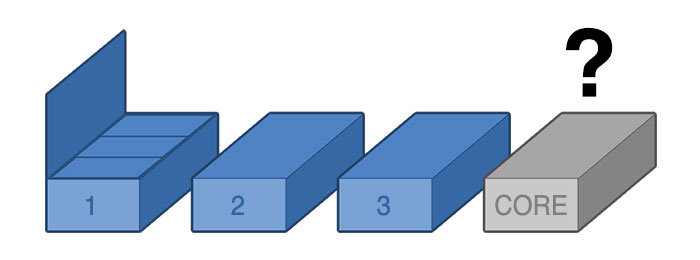
The core set has an identity problem. It's trying to make two different audiences happy at the same time and it's led to us making a set full of very odd compromises.
#3—The Metagame Issue
Constructed Magic is supposed to be a puzzle. The development team works very hard to craft an environment (many environments, actually, but the major focus is on Standard, the most played Magic format) where the players have to explore it and figure it out. The world, though, has changed a lot since Standard was first introduced. Major events used to happen maybe once a month and information from one event often took time to trickle out to the larger public.
Magic now has high-profile events every weekend, along with extended coverage that allows any player to watch from home. Add to that the growth of social media, and what was once a difficult puzzle gets solved much more quickly than it used to. Formats, especially Standard, get solved faster because the ability for players to iterate and learn has greatly accelerated.
#4—The Storytelling Issue
Just as design and development have worked hard over the years to evolve the mechanics of the game, so too has creative worked hard to evolve how the story of the game is told. We now have an ongoing cast of Planeswalkers and a portfolio of worlds to visit. The problem is that the pace of the storytelling is dictated by the blocks. Each block really wants to tell one story, which means that the overall pace of the storytelling is slow.
#5—The Space Issue
With Scars of Mirrodin block, we tested the waters of revisiting a world. Its success led to Return to Ravnica block. The success of that block has opened the floodgates of players requesting returns to other worlds. Let's assume that we want to return to all the worlds that were popular with the majority of the players. Let's also assume that we want to visit new worlds at least half the time. Just looking at the current mix, we have about ten years mapped out—and that's not counting any new worlds we might visit that we'd want to go back to. There simply isn't enough space to do all the things we want to do.
I bring up all these issues because it's important you understand what we are trying to solve in the next part of our story.
Problem Solving
The issues I've listed above have been with Magic for quite a while. With some, such as the third-set issue, they go all the way back to the early days of Magic. I cannot tell you the hours I've spent thinking about these issues. So it's interesting that the big break on solving it came during, of all things, a podcast.
One of the things I do in my podcasts (and in my column and in my blog) is to give general advice to game designers. A common lesson I give is this: "Make sure your game ends before your players are tired of playing it." I explain that if the game ends and the players are still invested, they end the game excited and wishing to play again. If the game ends after they wanted to stop, though, it makes them leave the game with a negative impression, which decreases their chances of playing again.
Anyway, later in the same podcast, I was talking about the third-set issue in passing when it hit me. Are we doing with our blocks the very thing I warn against doing in game design? Are we ending the blocks too late, after the majority of the players are ready to move on? Is the problem with the third set not execution but its very existence?
I talked to Aaron Forsythe (my boss) about my thoughts—that maybe the real problem with the three-set block structure was that we were doing three sets. Aaron independently had been thinking about the same thing. The big question, though, was what would we have to do to make a world where we did two-set blocks instead of three-set blocks?
Here are the issues.
It's important that we have a structure that players can follow. Having the "Magic year" always start with a large fall expansion set in a new world, for example, creates a rhythm that allows expectation and excitement. If we wanted to change our paradigm, it was important that we created a new structure that could likewise be anticipated by our audience. This meant that however we did it, each "year" would have to follow the same pattern.
This, of course, led to the idea of doing two blocks a year, the first being a two-set block and the second being a one-set block. We had toyed around with this idea before, during Zendikar block. The large set that would become Rise of the Eldrazi originally was going to be set in its own world. The problem with this idea was that, if we were going to shift to a Two-Block Paradigm, we wanted the second block to feel just as special as the first block. We thought having it be just one set, while the other block was two sets, would make the second block feel like a second-class citizen. No, if we were going to do a second block, we had to take steps to make it feel just as important as the first block.
What did that mean? Well, for starters, it meant that both blocks would have to have two sets—ideally one larger set to start and one smaller set to follow. That meant we'd have to add another set to the year. The Two-Block Paradigm already meant extra work for design and development, and especially creative, which would be on the hook to design not one, but two worlds a year. Aaron believed he could solve the extra workload issue with more staffing, but trying to fit a fifth normal expansion into the calendar proved an impossible task.
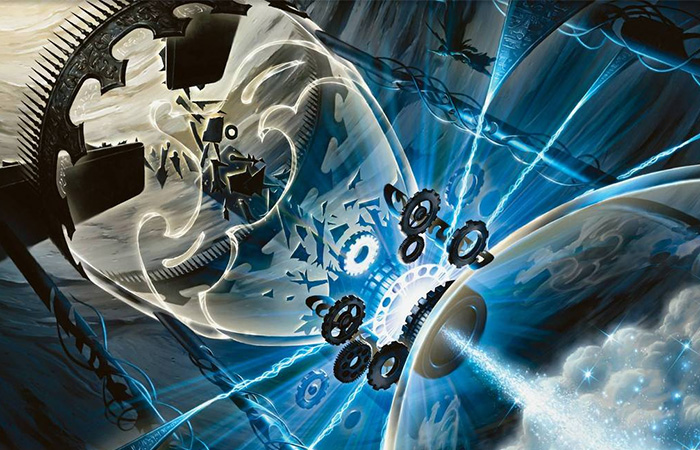
Art by Franz Vohwinkel
This led to the next rather radical proposal—what if we got rid of the core set? As I explained above, the core set has had a split identity problem for years, and it was only getting worse. What if we used the summer slot for the small set for the second block? This would mean we'd have to solve the problem of what to do with new players, but there had already been talk of creating a product line solely for them, anyway.
Okay, what if we used our four slots each year to do large, small, large, small, with the first two sets being the first block and the second two sets being the second block? What ramifications would that have? It meant that Standard would then have four blocks in it instead of two. The overall number of mechanics would rise slightly (over a two-year period, we'd be trading three large sets, three small sets, and two core sets for four large sets and four small sets) and the complexity of Standard would go up because it would then being pulling from four distinct environments rather than two.
Aaron and I took this concept to the rest of R&D (whose members, interestingly, had also been mulling this same basic idea—usually a sign that we're doing something right is when lots of people independently come to the same conclusion). Erik Lauer, the head developer, brought up an important point. If our goal was to make the second block of the Magic year feel the same as the first block, we would have to change how we did rotations. Whenever a new block entered the environment, we would have to rotate out an old block. This meant that Magic would then rotate not just in the fall but also in the spring.
Erik wasn't quite satisfied, though. As I explained above, development was trying to tackle the metagame problem of Standard getting stale too quickly. This new rotation would shake things up a little but it wouldn't have enough impact to solve the problem. You see, a metagame is more shaped by what leaves the environment than what enters. That's when Erik made a bold proposal. What if we changed Standard so cards rotated out after 18 months, rather than 24?
As I talked about above, I had some complexity concerns, as we were changing Standard from two blocks to four. Erik's suggestion would alter things so Standard would have three blocks, which, besides addressing Erik's metagame issue, would also address my complexity issue.
R&D talked through all the ramifications of this change and realized that not only did it solve the third-set issue, the core set issue, and the metagame issue, it also solved the storytelling issue and the space issue. Changing from one block to two would allow the creative team to tell its story at twice the pace and let design have two times as many slots to fill.
The Two-Block Paradigm (i.e., Meet the Butterfly)
Before I begin walking you through the changes, I need to explain something very important. The Two-Block Paradigm begins not this year (the fall of 2014) but next year (the fall of 2015). Khans of Tarkir block is the last of the three-set blocks. The reason this article is coming out now is that it's going to have an impact on how long Khans of Tarkir block will be legal for Standard, and we wanted you to understand that impact before you purchased the cards. With that being clear, let's look at exactly what's happening.
Change #1: Beginning in the Fall of 2015, Magic Blocks Will Be Two Sets Each
Starting with "Blood" block in September 2015, each block will have one large set that introduces the world and one small set that builds upon it. (I should note that this is the default and we reserve the right to have sets of different sizes if it serves the block.) Blocks will no longer have a third set.
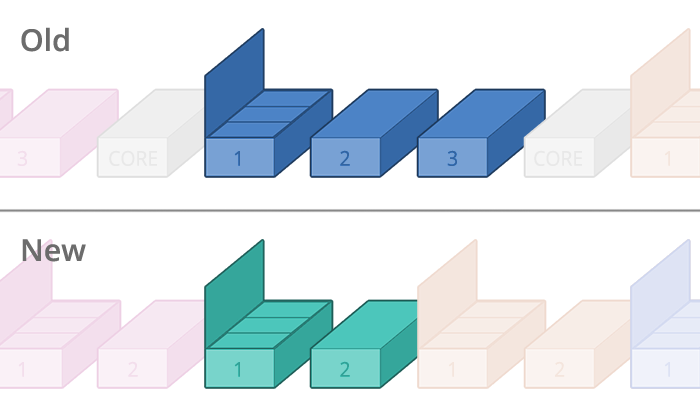
Change #2: Beginning in the Fall of 2015, Magic Will Have Two Blocks Per Year
Here's the typical schedule of the Magic year, with all the usual caveats about how Magic is about change and you should expect us to shake this up a bit over time: There will be a large fall expansion and small winter expansion set in World #1. Then there will be a large spring expansion and a small summer expansion, usually set in World #2. The first two sets will be part of one block and the second two sets will usually be part of a second.
Change #3: Beginning in 2016, the Core Sets Are No More
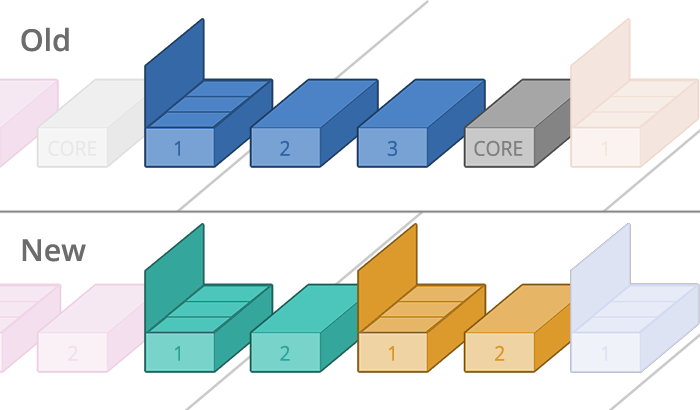
The summer of 2015 will have the last core set release, and in 2016, the summer set will be the second set of the block that started in spring of 2016.
Change #4: Beginning in 2016, the First Set of Each Block (the Fall and Spring Sets) Will Cause a Rotation
This in some ways isn't a change, but rather an adaptation to match the new Two-Block Paradigm. The first set of a block has always caused a rotation in the past. The Two-Block Paradigm just means that this now happens twice a year (in the fall and in the spring) rather than just in the fall.


Change #5: Beginning in 2016, Standard Will Be Three Blocks Rather Than Two Blocks
To keep the metagame more robust, we are changing the size of Standard. This change is the reason we are telling you this now, because we want you to understand that Khans of Tarkir will only be played in Standard for 18 months. This change should not have any impact on the set's role in other formats.
Let me show you a chart to explain how this will work.

| Time of Release | Large Set Released | Block/Sets Rotating Out | Standard, in Blocks |
Fall 2014 | Khans of Tarkir | Return to Ravnica | Still two three-set blocks |
Spring 2015 | "Louie" | Nothing rotates | Still two three-set blocks |
Fall 2015 | "Blood" | Theros block | Still two three-set blocks |
Spring 2016 | "Tears" | Khans of Tarkir and "Dewey" (winter '15) | Now three two-set blocks |
Fall 2016 | "Lock" | Next year's core set and "Louie" (spring '15) | Three two-set blocks |
Spring 2017 | "Barrel" | "Blood" block | Three two-set blocks |
From now through "Blood" block, Standard will stay as is, at two three-set blocks. Then, with the release of "Tears" block, the first spring block (in the spring of 2016), Standard will change over to be three two-set blocks. For the purposes of rotation, we are splitting the three sets of the Khans of Tarkir block, plus the core set to be released in 2015, into two, two-set blocks: Khans of Tarkir and "Dewey" is one and "Louie" and the 2015 core set is the other. Khans of Tarkir and "Dewey" will rotate out spring 2016 as a unit, and "Louie" and the core set will rotate out fall 2016 as a unit.
From this point on, the release of the first set of each block will rotate out the block three back, meaning that Standard will always consist of exactly three blocks, each of which will consist of no more than two sets. This also means that Standard will always consist of either five or six expansions.
The Changing Landscape
I started this article by promising you that this was a big announcement. I'm pretty sure I lived up to my hype. Before I wrap up for today I just want to address a few last things:
If this all doesn't happen for a year, why I am talking to you now? The reason is that the effects of the Two-Block Paradigm are going to impact how long Khans of Tarkir will be in Standard, and it was important to us that you understood these ramifications before you purchased the product.
Isn't it odd to rotate out one part of a block before the other? It is, but we felt okay about doing it for two reasons. First, "Tears" is going to be the first of the new spring blocks, and we wanted to treat it just like we were planning to treat every spring block after it. Second, while "Louie" has connections to Khans of Tarkir and "Dewey," it was designed as a set that could be played stand-alone. In the end, we decided that having one quirky rotation was better than pushing the entire system back a year.
What about Block Constructed? It will continue to exist as a format and will consist of a single block (up to two sets) of cards.
Finally, I want to stress what I'm most excited about the change. One of the things I've always loved about Magic is the excitement that happens every late summer/early fall. There is this crackling energy that comes from the community as everyone ramps up for the new block. It's always a time of expectation, excitement, and surprise, as the players anticipate and finally get to open their metaphorical present. It's truly a magical time and under the Two-Block Paradigm, it's now going to happen twice a year. I can't put into words how much that thrills me.
Whew! That was a lot of information in not a lot of space. I hope I did a good job breaking it all down.
I always end every article saying that I'm interested in feedback, and while that's always true, I'm very, very interested today. What do all of you think of the Two-Block Paradigm? Please feel free to email me or talk to me through any of my social media (Twitter, Tumblr, Google+, and Instagram) and share your thoughts or ask any questions.
Join me next week when Khans of Tarkir previews begin!
Drive to Work #150—2002
Today's first podcast is another in my "20 Years in 20 Podcasts" series. Today, I talk about the year 2002.
Drive to Work #151—Unhinged, Part 4
My second podcast today is the fourth in a five-part series on the design of Unhinged.
- Episode 151 : Unhinged, Part 4 (16.1 MB)
- Episode 150 : 2002 (18.6 MB)
- Episode 149 : Unhinged, Part 3 (16.1 MB)
- Episode 148 : Unhinged, Part 3 (15.0 MB)
- Episode 147 : Unhinged, Part 1 (17.0 MB)
- Complete Drive To Work Podcast Archive

